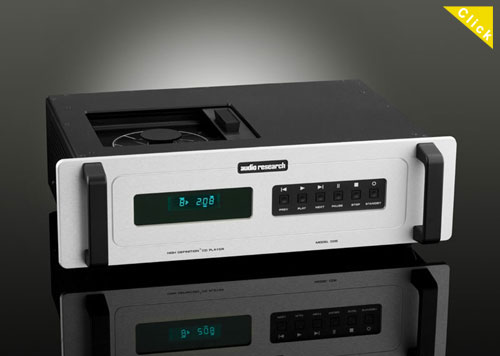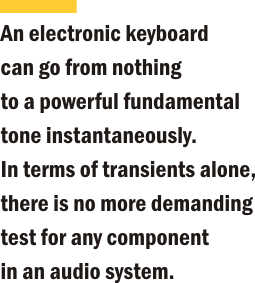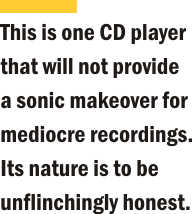Audio Research • CD5 CD Player
am by nature something of a Luddite, especially when it comes to audio equipment. There are always the adventurous sorts who are the early adopters of a new medium or technology, but I prefer to wait things out. I still recall with some vividness the first CD player I ever owned, an early Sony. It was not terribly expensive, a second-generation player that I bought from the Harvard Coop. What I remember most about it is that I never made it through a full CD on the thing without a splitting headache. Over the years, digital playback has improved to a degree I wouldn’t have thought possible back in those early days of the medium. But apart from a pair of horribly costly but marvelous-sounding mbl separates I reviewed for The Abso!ute Sound nearly a decade ago, I have always preferred the simplicity and unfussiness of a single-box player. To be brutally frank, I am simply not technologically savvy enough to deal with something like the latest stack of dCS upsampler, resampler, transport, separate clock and all the accompanying wiring and interfaces. While I love the idea of a music server, having to load it with so many recordings and connect it to my audio system makes me break out in a cold sweat and start looking for a vodka martini. I like things to be as simple as possible, but no simpler.
All of which brings me to the quite-wonderful Audio Research CD5 CD player. It is a no-nonsense, straightforward piece of gear, handsomely styled, as solid as a brick and as intuitive to use as an axe or a baseball bat. It is also a top-loader, which appeals to my essentially analog sensibilities. Physically putting a disc into a player, securing the beautifully machined (and individually balanced) magnetic clamp and sliding the CD5’s substantial door closed may be more complicated than using a drawer mechanism, but it is more viscerally satisfying to my sometimes-curmudgeonly mindset. Audio Research Corporation (ARC) should be no stranger to anyone reading this, and is certainly no stranger to digital playback. While ARC entered the source-component field later than most, it was immediately apparent that they had done their homework and worked out the kinks that bedeviled so many early adopters. The latest iteration of ARC's solid-state CD player is the CD5; Marc Mickelson is currently enjoying ARC’s Reference CD8, with its tubed output stage. I hope we can swap players at some point, as the difference between the two units are solely the CD8’s tubed output stage and the power-supply differences mandated by glowing glass. Apart from these distinctions, the two players are identical. Both use the same brawny Philips PRO2M CD drive mounted on an equally hefty suspended subchassis, the same 24-bit chipset (the source of and tweaks to which Audio Research will not disclose), the same fully balanced circuitry, and the same dependably excellent build quality one expects from this high-end stalwart. Audio Research’s chief listener Warren Gehl rang me up to offer the player for review and delivered it in person a couple of weekends later. I must mention for the sake of completeness that ARC went to the trouble of putting about 400 hours on my sample unit to save me the time of breaking it in. Warren explained that the CD5 (and most electronics) need a certain amount of break-in time for the signal paths to burn in and the capacitors to finally form. Given fifteen years of grim tedium breaking in gear for review, I knew he was speaking the truth, and I was able to get down to evaluative listening right off the bat. Let it be said that the CD5's character didn’t change in the slightest in the two-plus months I listened to it. Also worth mentioning is that ARC is one of the few audio companies to embrace a “green” attitude in designing its products. The CD5 is meant to be left on and in standby at all times, but it consumes a miniscule 14 watts in standby and only 20 watts in operation. ne of the first discs onto the CD5's mechanism was Philip Glass’s Akhnaten [CBS 42457], a longtime musical favorite that has always managed to sound somewhat opaque and undifferentiated, albeit musically breathtaking, no matter what I played it on. With the CD5, the opaqueness I had always attributed to this being an early digital recording was largely stripped away. Glass orchestrated the opera without violins, and the cellos and basses take on a bigger melodic burden than with many orchestral pieces. A sense of clarity that had always been lacking suddenly materialized, with the string sections individualized very nicely and the lucid rhythmic drive -- always vitally important to Glass’s music -- much more to the fore. The woodwind choirs’ embroideries were no longer obfuscated by a muzzy translucence but presented with a bracing clarity. As for the singers, the massed vocals of "The Family" were sumptuous and cleanly defined. Paul Esswood’s potent countertenor in the title role and the baritone recitatives of David Warrilow were more natural and less chesty and congested than I had been used to hearing, and to much more natural effect. Another favorite CD of mine is Shine [Starworld/BMG PD-6621] by the now-defunct Korean girl group Sugar. It combines a fizzy, engaging pop sensibility with catchy tunes, a wide variety of techno/dance influences and exceedingly slick production. That the girls can all sing convincing lead and lovely harmonies is the cherry atop the sundae. Yes, I am well aware that this is not exactly Audiophile Approved source material. So revoke my Audio Snobs’ Union card. I’ve loved girl-group pop since I first heard the Ronettes on AM radio when I was a mere sprout and this is nothing more or less than a 21st-century Asian riff on the same tradition. Besides, it always puts a big, stupid smile on my face when I listen to it. Oddly, Shine is one of those rare recordings that sounds better and better as one’s system improves. I’ve heard it dozens if not hundreds of times, and twice on systems anchored by the CD5, where it has suddenly opened up into a broad and deep soundstage with the girls’ (admittedly rather over-compressed) voices floating rather deliciously over the cinematic techno-pop backgrounds.
The CD5’s midrange was consistently excellent. It never shortchanged harmonic completeness, and this was most notable on vocals. Eva Cassidy’s Live at Blues Alley [Blix Street G2-10046] is an exemplary live recording, apart from the obviously artificial reverb on the singer’s voice. The CD5 points out the artificiality of that reverb but without untoward emphasis and, more importantly, without compromising Cassidy’s rich voice. The acoustic guitar, charmingly sung harmonies, and yearning melody of Sugar’s "Just For My Love" had just the right blend of sweetness and bracing clarity. Fritz Reiner and the CSO’s definitive recording of Richard Strauss’s Also Sprach Zarathustra [RCA Living Stereo 61494-2] showcased a naturally balanced string sound with a near-ideal blend of woody instrument bodies and a naturally shimmering top. The presentation of the top octaves is where Red Book digital has traditionally, and justifiably, been open to criticism for harshness and graininess. The CD5 showed finesse and refinement on every good recording. Subjectively, the player’s top showed no grain or grittiness anywhere, only an appealing combination of detail and oneness with the rest of the audible spectrum. The CD5’s dynamic performance was consistently exceptional. The ARC’s ability to resolve detail in a convincing musical context stood out on Live At Blues Alley, where Cassidy showed a thorough command of dynamic nuance. The subtleties of her phrasing and dynamic shading had a convincing and flowing presence through the CD5, which tracked her voice beautifully. Dynamics had a natural liquidity with no "ratcheting," only a natural billow or swell as provided by the music. Treble dynamics, which I don’t think get talked about enough, were unusually lifelike. There was no exaggerated hotness on crescendos, no dulling of the top end during quiet passages. Soundstaging was essentially a reflection of what was on each disc, with nothing added or subtracted. The shallow but very broad stage in Chicago’s Symphony Hall sounded just as it should with Zarathustra, and the CD5 caught what is most often heard on top-notch LPs -- the violins and violas, which are held horizontally under the chin, bloomed up expansively towards the microphones. Artificial soundspaces were truly capacious when appropriate. The cosmic expansiveness of "Clouds Again" and "Tri-Cycle Gliss" from Gong’s Live 25th Birthday Party [Voiceprint/GAS 101CD] was spot on, and so was the massively reverbed Duane Eddy-style "twangy" guitar sound created for Julee Cruise by David Lynch and Angelo Badalamenti on Floating Into the Night’s "Floating" and "Falling" [Warner Bros. 9 25859-2]. Most impressive was the length of the decay; the guitar hung in a huge cushion of air and slooowly diminished to a precisely defined point, always trailing away and never just winking out into the blackness of digital zeroes. Imaging was pleasingly precise without artificial highlighting or compartmentalizing of each voice or instrument into a neat little hermetically sealed box that stands outside the context of the whole.
nless you have a system composed entirely of lean, chilly-sounding components, I find it basically impossible not to recommend the CD5 with the highest degree of enthusiasm. It does nothing less than excellently with any kind of music one might wish to hear and brings with it Audio Research’s 40-year history of standing staunchly behind every component it has ever made and well-deserved reputation for reliability and general excellence. IPods? Phooey! Computers as a part of my audio system? Bunk! Simple is as simple does,
and the CD5 provides simple excellence in every way that is musically meaningful.
‘Nuff said for now, though a follow-up will be coming once I hear my temporarily
sidelined reference Lamm M1.2 amplifiers with the Wilson Sasha W/Ps.
|


 Shine also has some
brutally demanding synthesizer bass transients that no acoustic instrument will ever be
able to manage. "Natural" instruments have gradual attacks in the deepest bass.
With stringed instruments there is the process of plucking or bowing, which takes a small
but noticeable time between the beginning and end of the plucking or bowing motion; with
pipe organs there is the quick but clearly audible delay of the pipe beginning to speak
prior to the full impact of the note. An electronic keyboard can go from nothing to a
powerful fundamental tone instantaneously. In terms of transients alone, there is no more
demanding test for any component in an audio system. The CD5 handled torture tests like Shine’s
"Let’s Feel the Music" and Future Sound of London’s "Papua New
Guinea" from The Papua New Guinea Translations [Jumpin’ and Pumpin’
CD TOT52] with outstanding pitch definition and control. The Wilson Audio Sasha W/P would
certainly have let me know if anything had been missing from the CD5’s bass depth,
articulation and control, and nothing was. This ability to play depth-charge fundamentals
did not translate to any bloat or overripeness with pianos, cellos or double basses.
Timbral bloom and precision were never sacrificed on the altar of sheer power through the
ARC.
Shine also has some
brutally demanding synthesizer bass transients that no acoustic instrument will ever be
able to manage. "Natural" instruments have gradual attacks in the deepest bass.
With stringed instruments there is the process of plucking or bowing, which takes a small
but noticeable time between the beginning and end of the plucking or bowing motion; with
pipe organs there is the quick but clearly audible delay of the pipe beginning to speak
prior to the full impact of the note. An electronic keyboard can go from nothing to a
powerful fundamental tone instantaneously. In terms of transients alone, there is no more
demanding test for any component in an audio system. The CD5 handled torture tests like Shine’s
"Let’s Feel the Music" and Future Sound of London’s "Papua New
Guinea" from The Papua New Guinea Translations [Jumpin’ and Pumpin’
CD TOT52] with outstanding pitch definition and control. The Wilson Audio Sasha W/P would
certainly have let me know if anything had been missing from the CD5’s bass depth,
articulation and control, and nothing was. This ability to play depth-charge fundamentals
did not translate to any bloat or overripeness with pianos, cellos or double basses.
Timbral bloom and precision were never sacrificed on the altar of sheer power through the
ARC. The CD5 is nearly dead neutral
timbrally, though I did notice at times a slight, and I do mean slight, leanness or
coolness in the upper midrange and lower treble with both the EgglestonWorks Andra II and
the Wilson Audio Sasha W/P. This characteristic doesn’t define the player, and it
cannot be described as a failing; perhaps it is more a lack of a coloration common in
other digital players that romanticize this range. (This is the primary reason I would
like to hear its fraternal twin, the Reference CD 8, for purposes of comparison.
The CD5 is nearly dead neutral
timbrally, though I did notice at times a slight, and I do mean slight, leanness or
coolness in the upper midrange and lower treble with both the EgglestonWorks Andra II and
the Wilson Audio Sasha W/P. This characteristic doesn’t define the player, and it
cannot be described as a failing; perhaps it is more a lack of a coloration common in
other digital players that romanticize this range. (This is the primary reason I would
like to hear its fraternal twin, the Reference CD 8, for purposes of comparison.